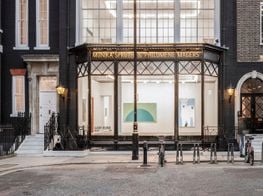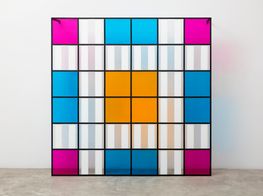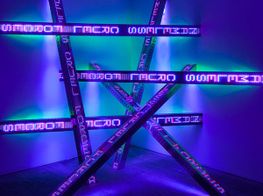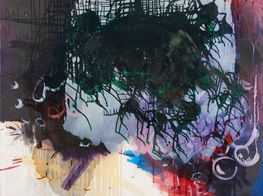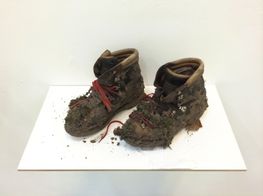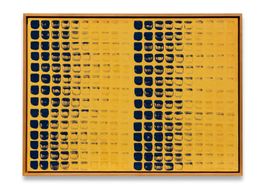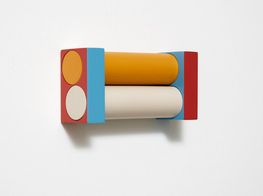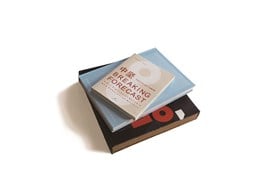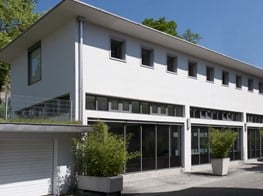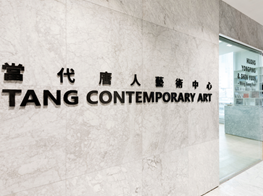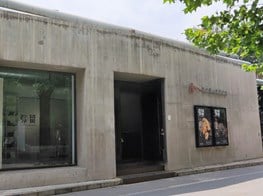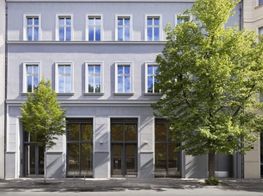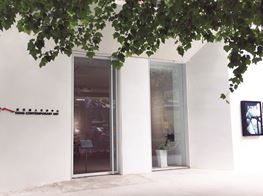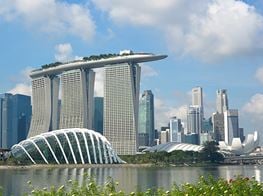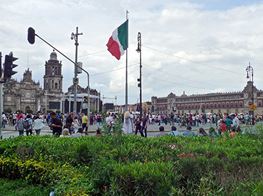Total Abstraction: A Report From Art Basel Miami Beach
General consensus? This years edition of Art Basel in Miami Beach was better than the last. Everything was “more” – more vibrancy, daring choices, and a more buoyant market. The Public program at Collin’s Park was a complete success, featuring performance pieces by artists including Ryan McNamara, Mungo Thomson and David Coleman on the opening night, and sculpture works by such artists as Huma Bhaba, Charlotte Posenenske and Thomas Houseago.
Then there were the Film and Kabinett Programs, not to mention Editions, featuring, amongst others, the Singapore Tyler Print Institute. In all, the fair was pulsing with energy. It felt like Tang Contemporary’s impressive standout Positions’ offering, Breath – Finance Dept. by Wang Yuyang: an installation of an office in which all silica-made objects were motored to replicate the act of breathing.
And so, within this living fabric of the art market and its networks, manifested in the regimented halls of the Miami Convention Center, works came alive. One that particularly stood out to both a prominent museum director and myself was Hans-Peter Feldman’s Seascapes (2013), a series of 15 found oil paintings of the sea framed in ornate gold at Mehdi Chouakri. Inexplicably, however, when we mentioned the work we both admitted to feeling guilty about our choice. Was it because this was an obvious work by an established artist and not actually “anything new”? Perhaps. But better Feldman than another Hirst, Koons, and Kusama, frankly. Of course, this says nothing of the caliber of those artists’ work besides the fact that they have become as common as air.
And Feldman’s piece was made even better when thinking about conceptual abstraction at a fair that has a clear preference for abstract painting and sculpture. It worked well with Oriol Vilanova’s Nova installation, Sunsets from… for Parra & Romero, which was an entire booth filled with 500 postcards from around the world depicting sunsets and Susan Hiller’s series of images of ships caught in stormy seas, Ship-Shape (2008/2012) at Timothy Taylor. These repeated sunset/sea tropes underlined the variations, appropriations and repetitions that texture art histories and the continuation of styles, motifs and trends.
This was visible in the rippling combinations on view at the fair. These included Sigmar Polke’s abstract paintings: one mixed media on paper piece from 1999 at Michael Werner and a resin on fabric painting from 1996 at McCaffrey Fine Art (showing an excellent selection of works by William Scott, Brigit Jürgenson and Polke) with the abstract renderings using acrylic on rayon by Pamela Rosenkranz (who was also showing other works at Karma International) at Miguel Abreu Gallery’s excellent booth (with standout works by Rey Akdogan and Sam Lewitt), including Drinking Water (One Slow Touch) (2013). Then there were David Renggli’s vibrantly colourful reverse paintings on glass, evocatively titled as a series as I Love You at Galerie Peter Kilchmann (also showing at Wentrup). There were variations on lines, too; from Julian Opie’s LED wall mount that depicted moving white lines across a black digital surface titled Forest (2013) at Lisson Gallery, also showing a canvas of alternating grey and white stripes from 1966 by Daniel Buren, to Georgio Griffa at Casey Kaplan, Ian Davenport at Alan Cristea and Lee Ufans’ From Line (1978) at SCAI The Bathhouse, all joining to form a wonderful historical perspective of one of art’s most prevalent tropes: the simple stripe.
Indeed, to explore lines of historical relation is something that Art Basel in Miami Beach is good for, especially when it comes to expanding one’s sense of the canon beyond the confines of Europe and North America.
That same museum director who loved Feldman’s piece also made note of another thing: that Art Basel in Miami Beach was good to view historical works. There were two versions of Marcel Duchamp’s famed boîte en valise presented at Francis M. Naumann and Galerie 1900-2000 to complement another version on show at the Perez Art Museum Miami. Meanwhile, at Hirschl Adler & Modern, exquisite works of surrealism produced in the mid-20th Century by Kay Sage included a wonderful De Chirico-esque painting, Third Paragraph (1953), as well as a work on paper, Arithmetic of the Wind (1947), which somehow recalled an image by Man Ray, Moving Sculpture (c. 1920) and also his oil on board rendering of the Flying Dutchman (1920) at the ever-excellent Francis M. Naumann Fine Art.
Indeed, to explore lines of historical relation is something that Art Basel in Miami Beach is good for, especially when it comes to expanding one’s sense of the canon beyond the confines of Europe and North America. This was exemplified in such booths as Mexico City’s Dan Galeria and Madrid’s Galería Guillermo de Osma, both showing works by Hércules Barsotti, with Guillermo de Osma also bringing forth works by Ivan Serpa, a pioneer in Brazilian abstraction, as well as works by Argentinian optical minimalist, Luis Tomasello, not to mention Carlos Cruz-Diez and Joaquin Torres-Garcia. Yet, this historical lateralisation is not limited to global relationships within the context of art history, but also in the fluidity and crossovers between styles. An excellent presentation of minimalist painters including Doug Olson and Ray Parker, complete with wall texts that included artist conversations or contextual overviews were on display at Wahsburn Gallery. One such text explained the links to Mondrian in the work of Leon Polk Smith, Black Line, Grey Rectangle (1992), which was illuminating to read in relation to the similarly pristine, abstract paintings by New Zealand Korean artist, Seung Yul Oh, showing with One and J at Nova.
Another thing that abounded at Art Basel in Miami Beach, as always, was colour, exemplified in paintings by Katharina Grosse at Galerie nächst St. Stephan Rosemarie Schwarzwälder and Johann König, and a suite of canvases by Katja Strunz at Contemporary Fine Art, as well as Al Held at Cheim & Read and William Monk at James Cohan, and in sculpture by Joana Vasconcelos at Galerie Nathalie Obadia. Homage was of course paid to masters of minimal colour composition, too, such as Joseph Albers in Sandra Gamarra’s excellent installation, Bodegón (El cuerpo del delito) (2013) at Gallery Leme’s Nova booth (also showing Mauro Piva and Mariana Mauricio). The work featured a postmodern deconstruction of Albers’ characteristic colour studies depicting squares painting on top of the other, often in differing shades of the same hue. In one series of paintings by Gamarra that re-appropriated Albers’s most characteristic compositions, black and white images were painted in the central square, depicting images that included dead bodies strewn under a tree, or corpses with their faces to the ground.
Another thing that abounded at Art Basel in Miami Beach, as always, was colour.
Gamarra’s works recalled a painting by Jenny Holzer in which a red silhouette of a soldier stands amidst a blazing fire at the Sprüth Magers’ booth, Lady Pink (1983-84), with text in red emblazoned over the painting reading: TRUST VISIONS THAT DON’T FEATURE BUCKETS OF BLOOD. Indeed, despite the colour, the issue of abstraction’s apparent violence became a subtle sub-theme in the fair this year, though perhaps this theme of violence has always been present, given the neoliberal context of the art fair space. Hence, of course there was the inclusion of two works that summed up the contradictions of an art fair as both a creative and commercial space: More (X4) (2012) by Doug Aitken at 303 Gallery, in which four large ‘MORE’ signs were positioned one on top of the other, and a neon sign of a cocktail glass with the words ‘Sorry’ written in hot pink back at Peter Kilchmann by David Renggli. Of course, such statements are as abstract as Scott Reeder’s sign positioned at Collins Park as part of Art Basel | Public, which reads: REAL FAKE, since the “fakeness” of it all during a fair like Art Basel in Miami Beach is pretty much a given; the place where FOMO (fear of missing out – on all the parties) practically produces the drive that gets it all going. But these days, that even reality itself has fallen into a void of festive abstraction could be a good thing. In the end, who cares about parties when there is too much art to see?
In reflection, perhaps Art Basel in Miami Beach in 2013 was best summarised by Cheng Ran’s hanging carpet The Last Generation (2013) at Galerie Urs Meile, which was woven with a text that read, in part: “It was not the best of times, it was not the worst of times, it was not the age of wisdom, it was not the age of foolishness.” One line that resonated most when thinking about the fair as a whole: “We had nothing before us, we had everything before us.” Total abstraction.

